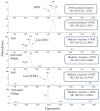Microbial Detoxification of Deoxynivalenol (DON), Assessed via a Lemna minor L. Bioassay, through Biotransformation to 3-epi-DON and 3-epi-DOM-1
- PMID: 28208799
- PMCID: PMC5331442
- DOI: 10.3390/toxins9020063
Microbial Detoxification of Deoxynivalenol (DON), Assessed via a Lemna minor L. Bioassay, through Biotransformation to 3-epi-DON and 3-epi-DOM-1
Abstract
Mycotoxins are toxic metabolites produced by fungi. To mitigate mycotoxins in food or feed, biotransformation is an emerging technology in which microorganisms degrade toxins into non-toxic metabolites. To monitor deoxynivalenol (DON) biotransformation, analytical tools such as ELISA and liquid chromatography coupled to tandem mass spectrometry (LC-MS/MS) are typically used. However, these techniques do not give a decisive answer about the remaining toxicity of possible biotransformation products. Hence, a bioassay using Lemna minor L. was developed. A dose-response analysis revealed significant inhibition in the growth of L. minor exposed to DON concentrations of 0.25 mg/L and higher. Concentrations above 1 mg/L were lethal for the plant. This bioassay is far more sensitive than previously described systems. The bioassay was implemented to screen microbial enrichment cultures, originating from rumen fluid, soil, digestate and activated sludge, on their biotransformation and detoxification capability of DON. The enrichment cultures originating from soil and activated sludge were capable of detoxifying and degrading 5 and 50 mg/L DON. In addition, the metabolites 3-epi-DON and the epimer of de-epoxy-DON (3-epi-DOM-1) were found as biotransformation products of both consortia. Our work provides a new valuable tool to screen microbial cultures for their detoxification capacity.
Keywords: 3-epi-DON; 3-epi-de-epoxy-DON (3-epi-DOM-1); Lemna minor; bioassay; biotransformation; deoxynivalenol (DON); detoxification.
Conflict of interest statement
The authors declare no conflict of interest.
Figures




References
-
- Jouany J.P. Methods for preventing, decontaminating and minimizing the toxicity of mycotoxins in feeds. Anim. Feed Sci. Technol. 2007;137:342–362. doi: 10.1016/j.anifeedsci.2007.06.009. - DOI
-
- Grenier B., Loureiro-Bracarense A.-P., Leslie J.F., Oswald I.P. Physical and chemical methods for mycotoxin decontamination in maize. In: Leslie J.F., Logrieco A., editors. Mycotoxin Reduction in Grain Chains. John Wiley & Sons, Inc.; Hoboken, NJ, USA: 2014.
-
- Goossens J., Vandenbroucke V., Pasmans F., De Baere S., Devreese M., Osselaere A., Verbrugghe E., Haesebrouck F., De Saeger S., Eeckhout M., et al. Influence of mycotoxins and a mycotoxin adsorbing agent on the oral bioavailability of commonly used antibiotics in pigs. Toxins. 2012;4:281–295. doi: 10.3390/toxins4040281. - DOI - PMC - PubMed
Publication types
MeSH terms
Substances
LinkOut - more resources
Full Text Sources
Other Literature Sources

